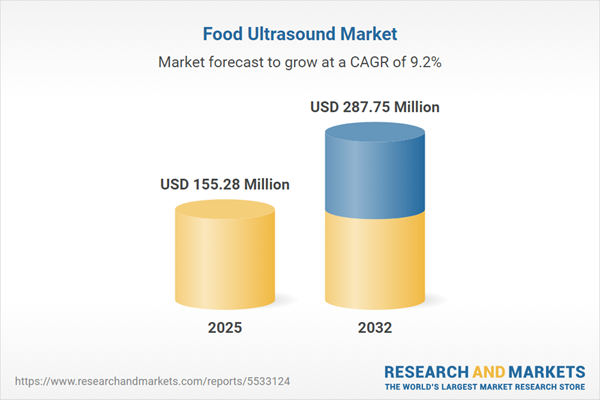Speak directly to the analyst to clarify any post sales queries you may have.
The global food ultrasound market is advancing as manufacturers seek non-thermal, energy-efficient solutions to elevate food quality and optimize efficiency amid regulatory and sustainability pressures. Executives are increasingly turning to food ultrasound for precise, reproducible outcomes that support operational agility and process innovation.
Market Snapshot: Food Ultrasound Market Accelerates on Demand for Quality and Efficiency
The Food Ultrasound Market grew from USD 142.42 million in 2024 to USD 155.28 million in 2025. It is expected to continue growing at a CAGR of 9.18%, reaching USD 287.75 million by 2032.
This robust growth reflects the adoption of advanced ultrasonic processing technologies in both established and emerging food manufacturing markets.Scope & Segmentation
This report offers in-depth analysis across a wide range of segments and technologies that define the food ultrasound landscape:
- Equipment Type: Benchtop Equipment (Industrial Bench, Laboratory Bench); Inline Equipment (Integrated Systems, Standalone); Portable Equipment (Battery Operated, Wired)
- Technology: Contact Ultrasound (Direct Contact, Immersion); Non-Contact Ultrasound (Air Coupled, Through Transmission)
- Frequency Range: High Frequency, Low Frequency, Medium Frequency
- Power Output: High Power, Low Power, Medium Power
- End-User Industry: Bakery Confectionery; Beverages (Alcoholic Beverages, Juices, Soft Drinks); Dairy Products (Cheese Production, Milk Processing, Yogurt Production); Meat Poultry
- Application: Cleaning, Emulsification, Homogenization, Process Monitoring, Quality Inspection (Composition Analysis, Defect Detection, Thickness Measurement)
- Geographic Coverage: Americas (North America, Latin America); Europe, Middle East & Africa (Europe, Middle East, Africa); Asia-Pacific (China, India, Japan, Australia, South Korea, Indonesia, Thailand, Malaysia, Singapore, Taiwan)
- Companies Covered: Hielscher Ultrasonics GmbH, Sonics & Materials Inc., Dukane Corporation, CHEERSONIC Ultrasonic Equipment Co. Ltd., Rinco Ultronics AG, Artech Ultrasonic Systems, Weber Ultrasonics AG, Marchant Schmidt Inc., GE Healthcare, Hitachi, Ltd.
Key Takeaways
- Food ultrasound technology is reshaping processing methods by offering flexible, non-thermal tools ideal for clean-label, sustainability-focused initiatives.
- Recent innovations in transducer design, digital controls, and modular equipment support integration in varied production scales, from small-batch research to high-volume industrial lines.
- Portable ultrasound devices enable on-site quality assessment and monitoring across remote and multi-site operations, enhancing process traceability and reducing downtime.
- Industry leaders are prioritizing cross-functional collaborations, combining R&D, production, and quality teams to accelerate the scaling of ultrasound solutions aligned with core business goals.
- Strategic partnerships between equipment suppliers, technology integrators, and academia drive rapid innovation and diversify application potential, notably in food safety and product differentiation.
Tariff Impact
New 2025 United States tariff measures have increased cost pressures on imported food ultrasound equipment, compelling procurement teams to reevaluate sourcing—shifting focus toward local assembly, domestic partnerships, and bundled service contracts. As a result, supply chain agility and contract flexibility are now critical for manufacturers and suppliers managing fluctuating landed costs.
Methodology & Data Sources
This analysis utilizes a multi-layered research approach. Extensive primary interviews with manufacturers, food processors, regulators, and technology experts provide real-world insights into operational needs. Supplementing this, secondary data from technical journals, white papers, patents, and official regulatory documents ensures a comprehensive market perspective.
Food Ultrasound Market: Why This Report Matters
- Supports evidence-based capital investment and long-term technology strategies by detailing trends across equipment, applications, and geographic markets.
- Identifies actionable pathways to optimize operations, accelerate innovation, and maintain compliance in a shifting regulatory environment for food processing executives.
Conclusion
The food ultrasound market is transforming operational models and technology strategies for manufacturers worldwide. Stakeholders using this report can confidently navigate technological evolution, regulatory complexity, and ongoing demand for higher food quality and process efficiency.
Additional Product Information:
- Purchase of this report includes 1 year online access with quarterly updates.
- This report can be updated on request. Please contact our Customer Experience team using the Ask a Question widget on our website.
Table of Contents
3. Executive Summary
4. Market Overview
7. Cumulative Impact of Artificial Intelligence 2025
Companies Mentioned
The companies profiled in this Food Ultrasound market report include:- Hielscher Ultrasonics GmbH
- Sonics & Materials Inc.
- Dukane Corporation
- CHEERSONIC Ultrasonic Equipment Co. Ltd.
- Rinco Ultronics AG
- Artech Ultrasonic Systems
- Weber Ultrasonics AG
- Marchant Schmidt Inc.
- GE Healthcare
- Hitachi, Ltd.
Table Information
| Report Attribute | Details |
|---|---|
| No. of Pages | 197 |
| Published | October 2025 |
| Forecast Period | 2025 - 2032 |
| Estimated Market Value ( USD | $ 155.28 Million |
| Forecasted Market Value ( USD | $ 287.75 Million |
| Compound Annual Growth Rate | 9.1% |
| Regions Covered | Global |
| No. of Companies Mentioned | 11 |









